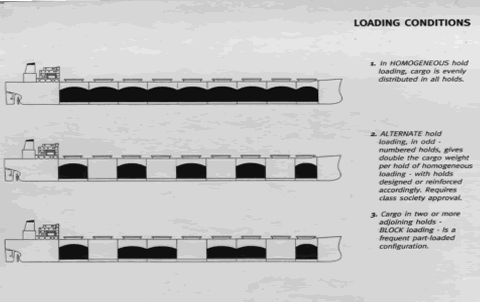Ship Safety Bulletins (SSB)
Date (Y-M-D): 2002-04-05
Subject: Deviation from the Load Conditions and Limitations given in the Approved Loading Manual
The following Ship Safety Bulletin draws the attention of owners and operators of vessels carrying or loading solid bulk cargoes to be aware of the potential problems caused by the use of cargo loading methods, quantities and hold sequences not shown in the ship's approved loading manual. In general, these conditions may not have been anticipated when their ships were designed, constructed and certified. All ships are designed with limits deliberately imposed on their operations to ensure that structural integrity is maintained. Block loading refers to stowage of cargo in a block of two or more adjoining holds - with holds adjacent to such blocks remaining empty.
The configuration is often adapted when the ship is only partially loaded. However, to avoid overstressing the hull structure in the part loaded condition, careful consideration must be given to the amount of cargo in each laden hold and the anticipated sailing draft.
It is important to be aware that over-stressing of the local structural members can occur even when the ship's loading instrument calculations indicate that the hull girder Still Water Shear Force ( SWSF ) and Still Water Bending Moment ( SWBM ) have remained within their permissible limits. It is well recognized that exceeding the permissible limits specified in the ships' approved loading manual may lead to overstressing of the ship's structure and may result in catastrophic failure of the hull structure. Thus, when deviating from the cargo load conditions contained in the ship's approved loading manual, it is necessary to ensure that both the overall ( SWSF and SWBM ) and imposed local structural limits are not exceeded IACS Recommendations are that part loaded, and block loading conditions should only be adopted in either of the following situations:
- The loading distributions are described in the ship's approved loading manual. In this case the ship's structure has been approved for the carriage of cargo in the specified loading condition and the loading conditions described in the ship's loading manual should be adhered to, or,
- The ship is provided with a set of approved local loading criteria which define the maximum cargo weight as a function of the ship's mean draft for each cargo hold and block of cargo hold(s). In this case, it is necessary to ensure that the amount of cargo carried in each hold satisfies the cargo weight, and draught limits specified by the local loading criteria and the hull girder SWSF and SWBM values are within their permissible limits.
As a result of a recent marine casualty and TSB Recommendations, it has been agreed that the Department of Transport, in coordination with international marine agencies, will bring the need for stricter adherence to approved loading manuals to the attention of ship owners, ship operators and ship masters in order to avoid undue structural stresses in bulk carriers.
Transport Canada Marine Safety Inspectors ensure, during Port Warden Inspections, that proposed loading plans and sequences are in accordance with the approved loading manuals. In the event that an improper loading condition is proposed by the vessel, the Port Wardens will not allow the ship to be loaded in this fashion and will require a plan to be submitted in accordance with the approved loading manual or approval by the flag State and classification society concerned prior to the issuance of a certificate of readiness to load. Upon completion of loading, the inspector will ensure that the vessel is loaded, in accordance with the approved loading plan and issue the certificate of fitness to proceed to sea.
Consequently, ship owners, ship operators, masters, classifications societies, charterers, terminal operators and shipping associations are herby informed that the above measures are applicable to all ships loading solid bulk cargoes in Canada. Ships should not load or carry cargo in load configurations that are not specifically authorized in the approved stability manual which has to be used in conjunction with any approved loading instruments. To avoid potential delays during inspections it is further advised that approved documents should be amended to include additional loading conditions or approval from classification be obtained for that particular load prior to the Port Warden issuing a certificate of readiness to load, as this is a deviation from the approved stability manual even though the ship's loading instrument calculation indicates that the vessels' still water SF/BM are within the limits.
Reference contacts: www.imo.org , www.iacs.org.uk.
ANNEX
Diagram published by the International Association of Classification Societies
The following document is available for downloading or viewing:
Deviation from the Load Conditions and Limitations given in the Approved Loading Manual (13 KB)
To access the Portable Document Format ( PDF ) version you must have a PDF reader installed. If you do not already have such a reader, there are numerous PDF readers available for free download or for purchase on the Internet:
Keywords: Questions concerning this bulletin should be addressed to:
2. Bulk Carrier Safety
3. Solid Bulk Cargoes
Jan Zwaan
613-991-3143
Marine Safety
Tower C, Place de Ville
11th Floor, 330 Sparks Street
Ottawa, Ontario K1A 0N8
To add or change your address, contact us at: marinesafety@tc.gc.ca
Owners of commercial vessels, registered and licensed, automatically receive Bulletins.


